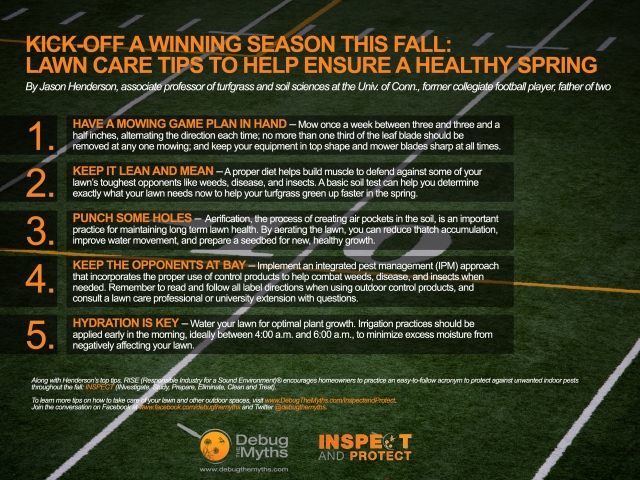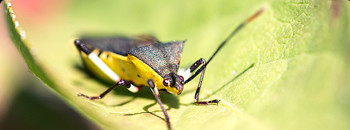 National Inspect and Protect Week (NIAP) is a week dedicated to educating homeowners about the importance of protecting their homes and outdoor spaces from potentially harmful pests. During the week of October 14-18, RISE (Responsible Industry for Sound Environment)® will be equipping homeowners with key steps to ensure a healthy home, as well as takeaway tips to help manage their outdoor spaces during the cool weather season.
National Inspect and Protect Week (NIAP) is a week dedicated to educating homeowners about the importance of protecting their homes and outdoor spaces from potentially harmful pests. During the week of October 14-18, RISE (Responsible Industry for Sound Environment)® will be equipping homeowners with key steps to ensure a healthy home, as well as takeaway tips to help manage their outdoor spaces during the cool weather season.
To “kick-off” NIAP Week, RISE spoke with Jason Henderson, associate professor of turfgrass and soil sciences at the University of Connecticut and an expert in maintaining healthy athletic fields. Henderson offers homeowners tips for keeping their yards pest-free this fall:
1. Have a mowing game plan in hand– Three main factors contribute to proper mowing: mowing height, frequency, and equipment maintenance. Generally, cool-season lawns should be mowed once a week between three and three and a half inches, alternating the direction each time. However, a game plan is important to win the game, so mowing frequency should be determined by the growth of the plant. As a rule, no more than one third of the leaf blade should be removed at any one mowing. Keep your equipment in top shape and remember to keep mower blades as sharp as possible. Dull blades will severely affect the appearance of the turfgrass and make the plants more susceptible to disease.
2. Keep it lean and mean– A proper diet helps build muscle to defend against some of your lawn’s toughest opponents like weeds, disease, and insects. A basic soil test can help homeowners and lawn care professionals determine exactly what your lawn needs to absorb to achieve optimal growth and prevent you from wasting time and money applying products that are not needed. For example, nitrogen applications made late into fall can actually help the turfgrass green up faster in the spring. Take a timeout to study and prep your lawn to win big next year.
3. Punch some holes– Aerification, the process of creating air pockets in the soil, can breathe new life into your lawn and is an important practice for maintaining long term lawn health. To see if your lawn is in need of some conditioning, dig a small sample of your lawn to see how far your grass’ roots go. If the roots are less than three to four inches deep, then your lawn may be a good recruit for aeration practices. By aerating the lawn, homeowners can reduce thatch accumulation, improve water movement, and prepare a seedbed for new, healthy growth.
4. Keep the opponents at bay– Weeds simply do not have the ability to stand up to heavy foot traffic like your lawn. Outdoor playing surfaces that have been severely compromised by weeds and show reduced turfgrass cover have been associated with greater potential for tripping or playtime injury. To be a true champion on the field, implement an integrated pest management (IPM) approach that incorporates the proper use of control products to help combat weeds, disease, and insects when needed. Remember to read and follow all label directions when using outdoor control products, and consult a lawn care professional or university extension with questions.
5. Hydration is key – Watering your lawn should be done to bridge the gap when Mother Nature does not provide enough natural precipitation for plant growth, but unfortunately, it’s the most frequent lawn care foul homeowners commit. Busy traveling between work, school and other activities, homeowners should strive to water correctly. Irrigation practices should be applied early in the morning, ideally between 4:00 a.m. and 6:00 a.m., to minimize excess moisture from negatively affecting your lawn. Applying water during the late morning or early evening can extend the amount of time the grass stays damp, making your lawn more susceptible to disease.
To learn more about National Inspect and Protect Week, and for more tips on how to take care of your lawn and other outdoor spaces, visit www.DebugTheMyths.com. Join the conversation on Facebook at www.facebook.com/debugthemyths and Twitter @debugthemyths.


